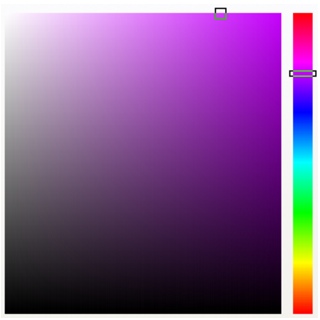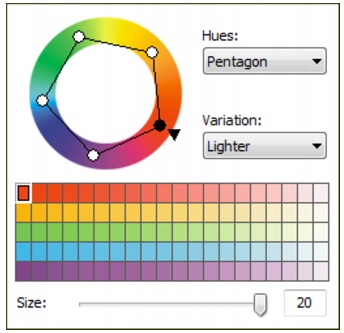Quick links to procedures on this page:
Choosing colors
You can choose background, foreground, and fill colors by using the color control area, color palettes, sampling, color viewers, color harmonies, or color blends.
For information about applying the colors you choose, see “Applying uniform fills”, “Drawing and painting”, and “Working with objects.”
Color control area
In the color control area, you can view the selected foreground, background, and fill colors, and you can choose new colors. The foreground color applies to all the paint tools, and to the color of text when it is first typed. The background color applies to the background of the image window, and the fill color swatch indicates the selected fill type and color.
Default color palette
A color palette is a collection of color swatches. In some programs, color palettes are known as “swatch palettes.”
You can choose foreground, background, and fill colors by using the default color palette, which contains 99 colors from the RGB color model.
Fixed or custom color palettes
Fixed color palettes are provided by third-party manufacturers. Some examples of these are HKS Colors, Focoltone, PANTONE, and TRUMATCH. It may be useful to have on hand a manufacturer’s swatch book, which is a collection of color samples that shows exactly what each color looks like when printed.
Some fixed color palettes — PANTONE, HKS Colors, TOYO, DIC, Focoltone, and SpectraMaster — are collections of spot colors. If you want to use these colors, but you don’t want to use spot colors, convert the spot colors to process colors when printing. For more information, see “Printing color separations.”
Custom color palettes can include colors from any color model or fixed color palette. You can save a custom color palette for future use. For more information about working with custom color palettes, see “Creating custom color palettes” and “Opening and editing custom color palettes.”
Sampling colors
When you want to use a color that already exists in an object or image, you can sample the color to achieve an exact match. By default, you sample a single pixel from the image window.
When you sample a color from a photo, what looks to be a solid-colored area may actually be subtly shaded or dithered. In this case, it is useful to average the colors of pixels in a larger sample area. You can set the sample area to 3 × 3 pixels, or to 5 × 5 pixels for high-resolution images. You can also sample pixels in a selected area.
If you want to sample and use numerous colors from the image window, you can store them on a custom color palette. For more information on custom color palettes, see “Creating custom color palettes” and “Opening and editing custom color palettes.”
Color viewers
Color viewers provide a representation of a range of colors by using either one-dimensional or three-dimensional shapes. The default color viewer is based on the HSB color model, but you can use this viewer to choose CMY or RGB colors. For information about color models, see “Understanding color models.”

Examples of color viewers
Color harmonies
Color harmonies work by superimposing a shape, such as a rectangle or a triangle, over a color wheel. Each vertical row in the color grid begins with the color located at one of the points on the superimposed shape.
The colors at each corner of the shape are always complementary, contrasting, or harmonious, depending on the shape you choose. The color harmonies let you choose a color model, and they are most useful when you need to choose several colors for a project.

Examples of color harmonies
Color blends
When you choose a color by using color blends, you combine base colors to produce the color you want. The color blender displays a grid of colors that it creates from the four base colors you choose.

Examples of color blends
To choose a color by using the color control area |
![]()
|
•
|
|
You can also access the Color docker to choose foreground, background, and fill colors by clicking Window
|
To choose a color by using the default color palette |
![]()

A pop-up color palette
|
•
|
|
You can display color names by pointing to a swatch.
|
|
•
|
|
You can also access the Color docker to choose foreground, background, and fill colors by clicking Window
|
To choose a color by using a fixed or custom color palette |
|
•
|
Foreground color swatch
|
|
3.
|
|
Choose a fixed or custom palette from the Palette list box.
|
![]()
|
•
|
|
Each color swatch on a fixed color palette is marked with a small white square.
|
|
•
|
|
You should use the same color model for all colors in an image; the colors will be consistent, and you will be able to predict the colors of the final output more accurately. It is preferable to use the same color model that you are using for the final output. For more information about reproducing colors accurately, see “Managing color for display, input, and output.”
|
![]()
|
•
|
|
You can also access color palettes in the Color docker by clicking the Color palettes button, and choosing a palette from the list box. If the Color docker is not open, click Window
|
To sample a color |
|
The default sample size is 1 pixel.
|
![]()
|
•
|
|
In the image window, a preview swatch is attached to the Eyedropper tool, along with a box listing the color model component values.
|
![]()
|
•
|
|
You can also activate the Eyedropper tool by pressing the E key. Click the Spacebar to return to the previously selected tool.
|
|
•
|
|
You can also use the Image info docker to view the color model component values for an image pixel, such as the red, green, and blue components of a pixel in an RGB image. If the Image info docker is not open, click Window
|
To choose a color by using a color viewer |
|
•
|
Foreground color swatch
|
|
3.
|
|
Choose a color model from the Model list box.
|
![]()
|
•
|
|
If you choose a color that is outside of the printer gamut, Corel PHOTO-PAINT displays the closest in-gamut color. This color is displayed in the Reference area, in the small swatch beside the New color. You can either choose this closest in-gamut color or you can correct the out-of-gamut color. For information about color correction, see “Managing color for display, input, and output.”
|
![]()
|
•
|
|
You can also access color models in the Color docker by clicking the Color viewers button and choosing a color model from the list box. If the Color docker is not open, click Window
|
To choose a color by using color harmonies |
|
•
|
Foreground color swatch
|
|
7.
|
|
Click a color swatch on the color palette below the color wheel.
|
![]()
|
•
|
|
If you choose a color that is outside of the printer gamut, Corel PHOTO-PAINT displays the closest in-gamut color. This color is displayed in the Reference area, in the small swatch beside the New color. You can either choose this closest in-gamut color or you can correct the out-of-gamut color. For information about color correction, see “Managing color for display, input, and output.”
|
![]()
|
•
|
|
You can use this procedure to choose a fill color by double-clicking the Fill color swatch
|
|
•
|
|
You can swap the Old color (the current foreground or background color) and the New color (which has been chosen in the color selection area) by clicking Options
|
To choose a color by using color blends |
|
•
|
Foreground color swatch
|
![]()
|
•
|
|
Only colors that are on the default color palette can be blended. To blend other colors, you must change the default color palette. For more information, see “To open a custom color palette.”
|
![]()
|
•
|
|
You can use this procedure to choose a fill color by double-clicking the Fill color swatch
|
|
•
|
|
You can swap the Old color (the current foreground or background color) and the New color (which has been chosen in the color selection area) by clicking Options
|